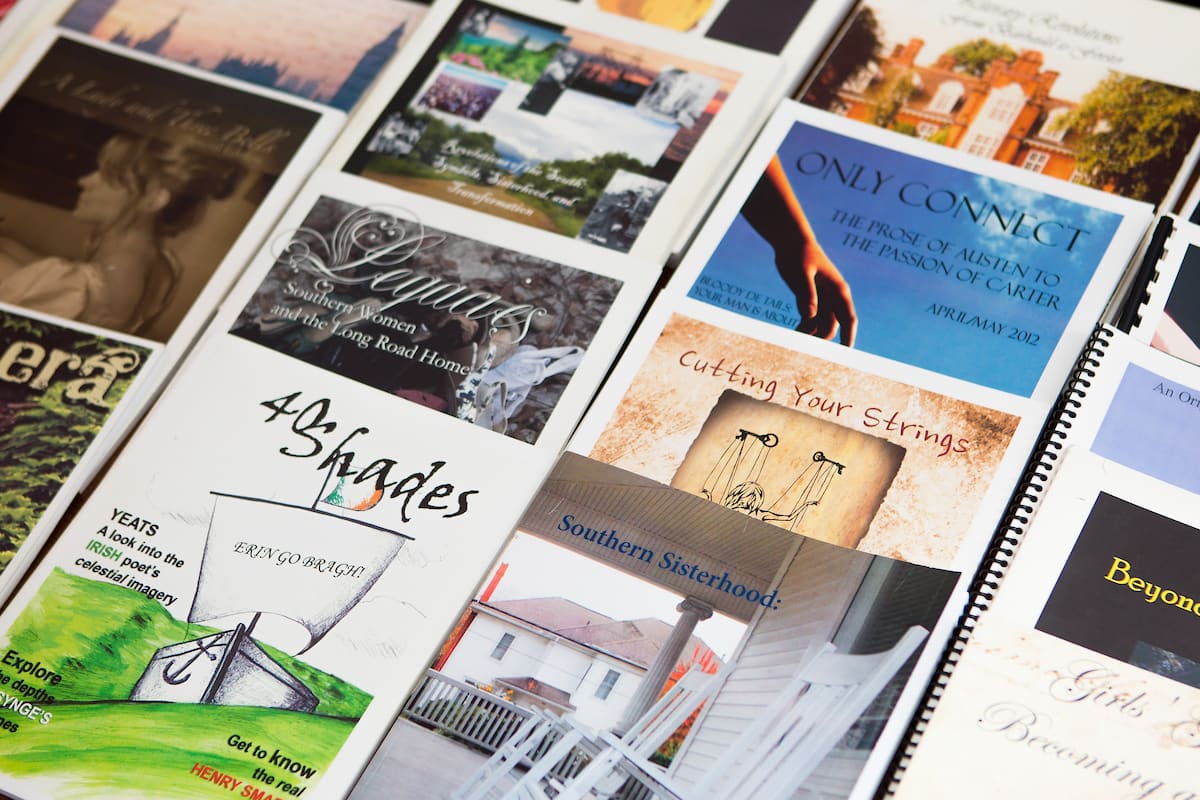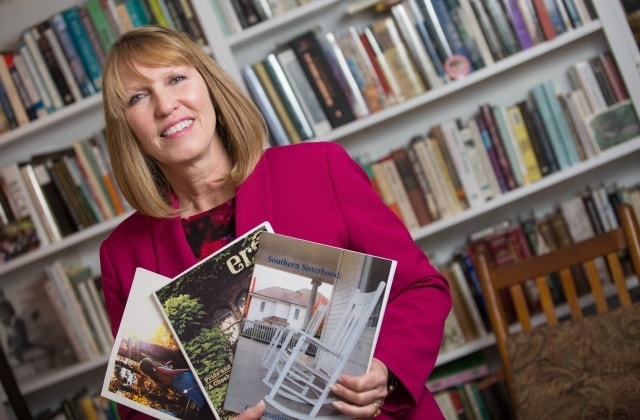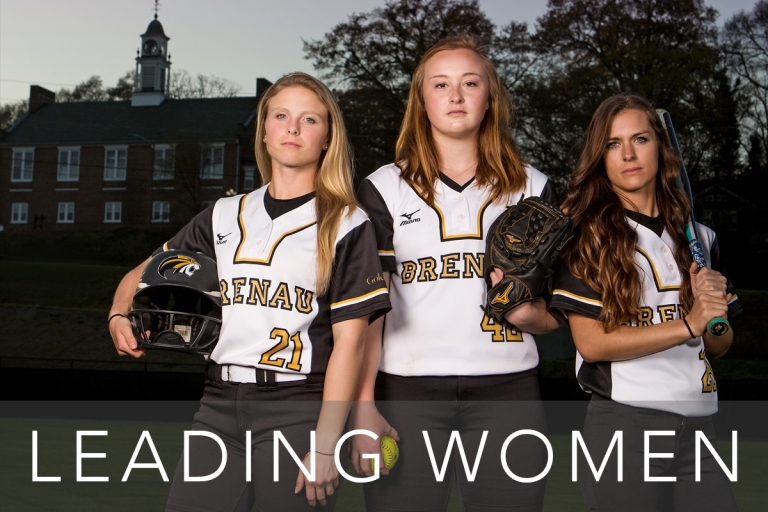Dean Debra Dobkins Gives Students Invaluable Lessons with Published Works
Dean Debra Dobkins Gives Students Invaluable Lessons with Published Works
The sky darkened, sirens could be heard all over Gainesville, and Brenau students received an emergency text message directing them to the nearest tornado shelter. The timing could not have been worse for Debra Dobkins’ students, who were sweating a strict deadline for their labor-intensive, painstakingly revised and much-anticipated literary anthology.
“A group of us were working on editing the final proof,” says Rebecca Jarrett, junior English major in the Women’s College. “In the library, they came on over the loudspeaker and told us that we either needed to evacuate or move to their shelter location, which was their bathroom, where everybody was swarming. Not wanting to be cramped in there, we rushed over to the Tri Delta house, where we all huddled in the stairwell and worked the entire time through the tornado.”
Adds Katelyn Rochford-Price, senior English and theater major and Jarrett’s co-editor, “Come hell or high water, we had to get our book to the printer by the end of the day. It was a real-world, business deadline. We couldn’t let bad weather stop us.”
Their dedication paid off. The result, titled Southern Sisterhood: Conversations & Confessions, is a lovingly polished collection of student essays, photos, poetry and a couple of downhome recipes. It is professionally bound, with a cover photo of companionable rocking chairs on a porch, inviting the reader to linger for a visit. Inside are meditations on the themes of authors Lee Smith, Alice Walker and Eudora Welty, with lofty titles such as Morgana as a Microcosm: Universal Symbols of Ritual, Time, and Mortality; I Walked in My Body Like a Queen; and “Fair and Tender Ladies” and Religion: A “Christ-haunted” Ivy Rowe.
“The most rewarding aspect was seeing the finished product,” Rochford-Price says. “Seeing my name next to all of my colleagues’ in print was a unique experience and provided more recognition than any other project I’ve done in my entire academic career so far.”
Creative Response
Dobkins, a literature professor and dean of the Women’s College, has made these anthologies an assignment for most of her classes since 2001, totaling 32 volumes covering Southern, British, Irish and feminist material. If you peruse a stack of them all at once, they offer a dazzling, mythopoetic reading experience rich in both sense and sensibility. (One essay addresses contraception in the era of Jane Austen.)
“My inspiration was a desire to help students practice the art of revision and to pique their creativity,” Dobkins says. “I wanted an inventive way for them to respond to literature. My other intent was to design a project for which each student could contribute valuable talents. So if she wasn’t a great writer or editor, maybe she was a fabulous artist or sharp graphic designer or shrewd negotiator. I wanted them all to shine – and walk away with an artifact of our experience together, more permanent than an all-nighter spent cramming. Of course, I wanted them to reflect on our conversations and the texts we shared and to hone communication skills, but I also wanted them to be proud of their accomplishments.”

The students do everything – writing, editing, photography, layout and design, compiling literary citations and annotations, even haggling with a printing company over expenses. By any standard, this undertaking would be ambitious, but it is even more impressive given the time constraints: Each class produces an entire book within three weeks, and Dobkins’ standards are high.
“They typically need to revise their work at least three times,” the professor says, “but they edit each other. I just stand back and try to keep them from crashing over a cliff.”
Chandra Hopkins, WC ‘05, agrees that revision is key, as is becoming acclimated to others critiquing one’s own work: “A bit like hearing your own voice on video or voicemail, creative writing is personal, and it was hard initially to move past the discomfort in sharing work and owning it as my own, warts and all.”
Dobkins nods, sighs and says, “It gets really intense, and there is always some drama, but that’s part of the experience that I think prepares them for their jobs after they graduate. They have to work together to solve problems and overcome disagreements. In the process, many discover talents they didn’t realize they had. I had one dyslexic student tell me she never dreamed in a million years that she would be part of publishing a book.”
More than just a pretty souvenir, the books also function as a practical part of a professional portfolio.
“I really wanted to write for a living after college,” says Christy Edwards, WC ‘05, executive director of Horizons Savannah, a nonprofit that provides low income students with a summer learning experience. “The obstacle was that other than some writing I did for the Alchemist, I didn’t have any published work. So I dug out the anthology and sent a copy of my Faulkner essay to an editor. I got the job and wrote features and small talk for the original issue of South magazine.”
Literary treasures
Hopkins contributed a poem about her grandfather’s cemetery and an essay about Eudora Welty for her class’s book. Since graduating from Brenau, she earned both a Master in Fine Arts and a doctorate in theatre and performance studies. She now works as a theatre professor at Converse College, where she employs many of the skills she honed while working on the anthology.
“I simply wouldn’t be the writer I am today without the influence of Dr. Dobkins and many other Brenau professors and mentors who shaped the way I think and see the world,” she says. “The most gratifying aspect for me was working on our writing as a team in service to a collective project. I think working on the shared project made us closer as students, fellow writers and as women.”
Dobkins notes, “Especially with the Southern literature, I could see the students really studying the way female characters handled certain situations, and then they would apply those lessons to their own lives, which is what literature is all about.”
Ashley Lee, WC ‘14, worked on the Dobkins books for all four years of her time at Brenau. Her favorite issue is the edgiest one, Cutting Your Strings, which explores the subversive, bloody, feminist fairy tales of Angela Carter. For the numerous photos in this collection, all of the students wear somber, defiant expressions.
“Carter’s work is so acerbic and irreverent,” says Lee, who is a development coordinator at Columbus State University. “It was fun to bring her twisted, sardonic world to life at Brenau, which is such a beautiful, theatrical and historical place. It’s one thing to read literature on the surface, but producing these books helps you react on a deeper, personal level. Fusing your interpretations with those of others helps you understand what is going on in today’s context, and it opens up new ways of viewing the world, which is the purpose of an education. I can’t even imagine the university without these books. They have become another one of Brenau’s great traditions.”
In fact, the anthologies have become so entrenched and esteemed in campus life that they now are catalogued in the Special Collections section of the Trustee Library, near other rarefied books that include signed copies of work by Eugene O’Neill and Edna St. Vincent Millay, along with the four-volume set of John James Audubon’s Birds of America, and others.
“There is a vibrancy in the writing here,” says Benjamin Barton, collection development librarian. “I think having these pieces printed in a bound volume is a truly special way for the students to showcase the quality of their work. Placing these anthologies in our Special Collections ensures that their work will be preserved for students and faculty to enjoy in the years to come.”
Dobkins leafs wistfully through an issue titled All the Living and the Dead: Prophetic Revelations in Irish Literature, illustrated with original, artsy photos from a cemetery. “Every book brings back certain memories of the students for me,” she says. “With every issue, they exceed my expectations, and they can take great pride in the proof that they are published writers.”


